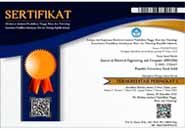Voice Warning to Identify Distance to Obstacles on Smart Cane for Blind People
Authors (s)
(1) * Atmiasri Atmiasri
 (Universitas PGRI Adi Buana Surabaya)
(Universitas PGRI Adi Buana Surabaya) Indonesia
(2) Akhmad Solikin (Universitas PGRI Adi Buana Surabaya)
Indonesia
(3) Rasyida Shabihah Zukro A. (Universitas PGRI Adi Buana Surabaya)
Indonesia
(*) Corresponding Author
AbstractBlind people are often hampered in their mobility, while currently available assistive technology includes manual sticks and electronic mobility devices. Currently, the development of smart canes is still being carried out in many studies. Smart cane works by detecting the distance of the cane to obstacles in front of you. From detecting this distance, the response the user gets is generally in the form of vibrations and sounds from the buzzer. The sound provided by the buzzer cannot differentiate the distance between obstacles. Therefore, this study proposes the existence of additional sound playback responses to differentiate far, middle, and near obstacles. Apart from that, the design of the prototype refers to the shape of a flashlight. The smart cane is designed using an Arduini UNO microcontroller with a rechargeable battery power supply with three response components, namely two ISD 1820 modules connected to a speaker to detect long distances (201-300 cm) with a "Hati-hati" sound and medium distances (101-200 cm) with an "Awas" sound, as well as a buzzer and piezoelectric component in the form of a "beep" sound and vibration for close distances (1-100 cm) to obstacles. The result is that both the ultrasonic sensor and response components work according to design. Apart from that, the rechargeable battery supply feature and the implementation of the prototype design make it easier for users to store and use for daily activities.
|
Keywords
Smart Cane; Ultrasonic Sensor; ISD 1820; Voice
Full Text: PDF
Refbacks
- There are currently no refbacks.
Copyright (c) 2023 Atmiasri -

This work is licensed under a Creative Commons Attribution License (CC BY-SA 4.0)
Journal of Electrical Engineering and Computer (JEECOM)
Published by LP3M Nurul Jadid University, Indonesia, Probolinggo, East Java, Indonesia.








